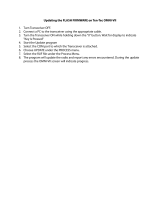
ADCP-75-110 • Issue 2B • July 2001
Page 5
© 2001, ADC Telecommunications, Inc.
1.2.3 Fault Detection and Alarm Reporting
The DHU is designed to detect internal circuitry faults and optical port faults. Various front
panel Light Emitting Diode (LED) indicators turn from green to red or yellow if a fault is
detected or an optical input is lost. A set of alarm contacts (normally open and normally
closed) are also provided for reporting an alarm to an external alarm system when a fault is
detected. Both major alarm (all fault conditions except high temperature) and minor alarm
(high temperature fault condition) contacts are provided.
1.2.4 RF Signal Connections
The RF signal connections between the DHU and the BTS are supported through two type N
female connectors. One connector is used for coaxial cable connection of the forward path RF
signal. The other connector is used for coaxial cable connection of the reverse path RF signal. In
most installations, the DHU will not connect directly to the BTS but will be connected to an
interface device such as the RIU or the LIU. Additional information concerning the DHU to BTS
interface is provided in the Digivance ICS Remote Interface Unit User Manual (ADCP-75-113) and
in the Digivance ICS Local Interface Unit User Manual (ADCP-75-114).
The DHU requires a composite forward path RF signal level of –20 dBm or lower. An
overdrive limiter protects the system against excessive inputs but does not function during
normal operation. The DHU does not have Automatic Gain Control (AGC).
1.2.5 Optical and Electrical Interface Connections
Operation of the DRUs and DEUs is supported by six optical and six electrical ports. Each optical
and electrical interface connection includes a status LED, a small form factor LC type optical
transceiver, an RJ-45 DC power jack, and a port enable/disable switch. An optical port may be
connected to a DRU, a DEU, or not used. An electrical port may be connected to a DRU or not
used. Unused ports require no connections at all and are disabled via the corresponding port
enable/disable switch. When disabled, the port LED is off, the alarm reporting function is disabled,
the laser is off, and the DC power is off. Enabling the enable/disable switch activates all functions.
1.2.6 Powering
The DHU is powered by 120–240 Vac (50–60 Hz) power which is supplied through a standard
three-conductor AC power cord. The power cord is provided with the DHU and is 98 inches
(2.5 meters ) long. A resetable circuit breaker/On-Off switch is provided at the unit front
panel. The switch applies power to the DHU internal power supply.
1.2.7 Cooling
Continuous air flow for cooling is provided by dual fans mounted on the right side of the housing.
A minimum of 3 inches (76 mm) of clearance space must be provided on both the left and right
sides of the DHU for air intake and exhaust. An alarm is provided that indicates if a high
temperature condition (>50º C/122º F) occurs. The fans may be field-replaced if either fan fails.
1.2.8 User Interface
The DHU user interface consists of the various connectors, switches, terminals, and LEDs that
are provided on the DHU front panel. The DHU user interface points are indicated in Figure 3
and described in Table 1.




















